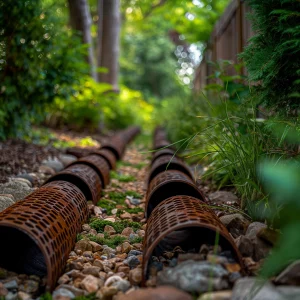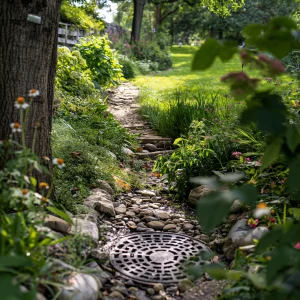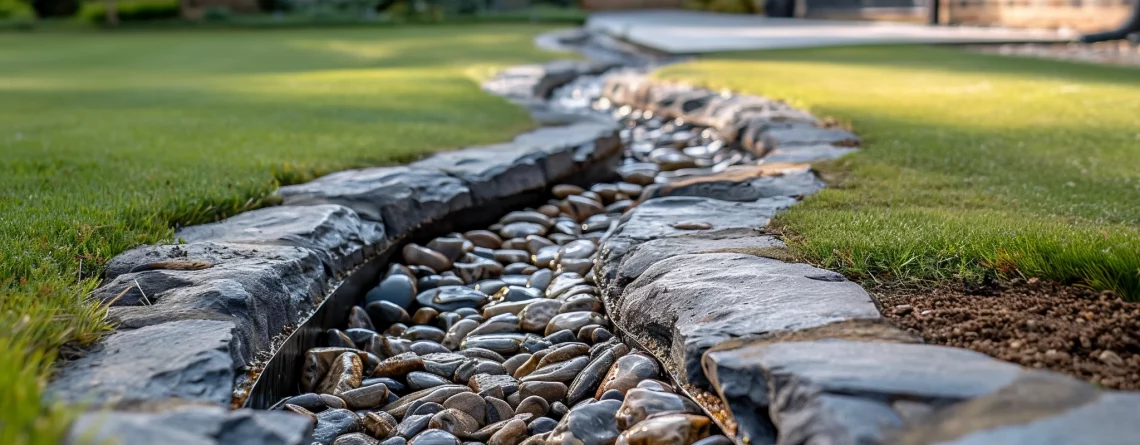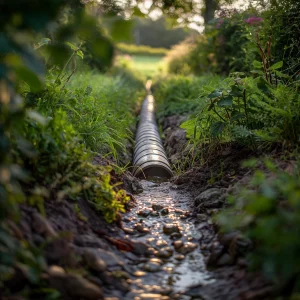Quick Guide: Installing a French Drain in Your Backyard
What is a French Drain?
A French drain is an underground water diversion system crucial for managing excess water in your backyard. This ingeniously simple construction prevents water from pooling around home foundations, which can cause structural damage and soil saturation. At its core, a French drain is a trench filled with gravel and a perforated pipe, cleverly hidden beneath the landscape, designed to redirect both groundwater and surface runoff.
Composition and Structure
Constructing a French drain requires a few essential materials: a perforated drain pipe, ample gravel, and landscape fabric to keep the system free from debris and functioning correctly. The drain design involves laying a trench, often at the lowest point in your yard, aligning it with the natural water flow. This strategic placement ensures that water is collected efficiently before it causes any damage or inconvenience.
The Purpose
Installing a French drain offers multiple benefits, which extend beyond simple water redirection. Not only does it protect structural foundations by mitigating hydrostatic pressure and moisture-related issues, but it also enhances garden health by improving soil drainage. This can be particularly beneficial in areas prone to heavy rainfall or where the soil retains water. A well-planned French drain system can prevent the saturation that leads to garden and lawn deterioration over time.
Choosing the Right Location
Selecting the appropriate location for your French drain is paramount. It should ideally be placed away from the building to prevent water from seeping towards the foundation. It’s essential to assess the natural slope of your yard and plan the drain’s path to follow this gradient, ensuring effective water flow away from critical areas. By considering these elements, you can maximise the functionality of the drain and ensure it performs as needed without causing unforeseen issues.
“Choosing the right location for a French drain in your backyard is absolutely crucial. You need to identify the lowest point of the yard and ensure it aligns with the natural water flow. This optimises the drain’s efficiency in redirecting water away from your home and garden, preventing potential damage. A strategically placed drain can be the difference between a dry basement and costly water damage repairs” – Mark Cordner, Regency Drainage Brighton.
Materials and Tools Required
The installation of a French drain is a straightforward process but requires specific tools and materials:
- Perforated Drain Pipe: This is the core element that captures and redirects water.
- Gravel: Facilitates effective water filtration and flow around the pipe.
- Landscape Fabric: Prevents soil from entering the gravel and clogging the system.
- Optional Sand: This can be used for additional filtration.
- Tools: You will need a trenching shovel or a trencher, a level to ensure your trench has the correct slope, a rake, measuring tape, stakes, and scissors.
Planning and preparing with the right materials and tools can make the installation smoother and more efficient.
Planning and Design
Before you begin digging, it is crucial to plan the layout of your French drain thoroughly:
- Assess the Slope: Understanding the gradient of your yard is essential to ensure proper water flow.
- Soil Type: Different soils have varying absorption and drainage properties which can affect the efficiency of your drain.
- Drain Path and Endpoint: Plan where the trench will run and where the water will be redirected.
- Local Regulations: Check building codes and contact local utilities to avoid disrupting underground services.
Installation Process
Digging and Preparing the Trench
Mark the layout of your trench using stakes and string to ensure precision. Dig the trench between 6 to 12 inches wide and 18 to 24 inches deep, maintaining a minimum slope of 1% to facilitate water flow. The depth and width can vary based on specific yard needs and the volume of water to be redirected.
Laying the Foundation
After digging, line the trench with landscape fabric and add a layer of gravel. This base not only supports the pipe but also aids in filtration. Carefully lay the perforated pipe with the holes facing downward to capture maximum water. Cover the pipe with more gravel, then wrap the top with fabric to prevent soil from filtering down into the gravel. Finally, replace the topsoil, which can be seeded with grass or covered with mulch, integrating the system seamlessly into your landscape.
Managing Water Flow
The orientation of the pipe is critical to its functionality. With the holes placed downward, water is effectively captured from the bottom up, reducing the risk of clogs and ensuring optimal performance. The endpoint of the drain is also vital; depending on local regulations and environmental considerations, options include dry wells, drainage ditches, or even direct connections to street drains.
Maintenance and Inspection
Maintaining a French drain is straightforward but requires diligence. Homeowners should regularly inspect the system, especially after heavy rainfall, to ensure it remains unclogged and operational. This includes checking for sediment build-up, ensuring the integrity of the pipe and fabric, and verifying that the exit points are clear and allow the free flow of water. Regular checks help in the early identification of potential issues, such as pipe collapses or clogs, which can be addressed before causing significant problems.
Preventative maintenance, such as clearing debris from the landscape fabric and refreshing the gravel as needed, can greatly extend the life and effectiveness of your French drain. Keeping the system well-maintained not only protects your property but also saves on potential future repair costs.
Legal and Regulatory Compliance
When considering the installation of a French drain, it is crucial to adhere to legal and regulatory standards to ensure both effectiveness and compliance. Before any ground is broken, homeowners must call 811 to check for any underground utilities affected by trenching. This not only ensures safety but also prevents potentially costly damages to utility lines.
Additionally, local building codes should be reviewed to understand specific requirements or restrictions related to drainage systems in your area. In some cases, permits may be required, and specifications such as the depth, slope, and materials used may be regulated. Consulting with a professional can provide peace of mind and ensure your system meets all local standards and functional requirements.
Benefits of Installing a French Drain
The advantages of implementing a French drain system extend beyond simple water management. First and foremost, such systems significantly mitigate the risk of flooding, which can lead to extensive property damage and costly repairs. By efficiently redirecting excess water, homeowners can protect their foundations from the erosive forces of standing water. Additionally, French drains promote healthier garden and lawn areas by providing better soil drainage, which prevents over-saturation and promotes root growth.
Furthermore, installing a French drain can enhance the overall drainage of the garden area, which is particularly beneficial in regions that experience high rainfall levels. This improvement can lead to a more vibrant and resilient landscape, contributing to the property’s aesthetic and overall market value. The proactive installation of drainage systems like French drains also demonstrates a commitment to property maintenance. This aspect can be appealing to potential buyers if the property is ever put on the market.
Cost Considerations
The cost of installing a French drain varies based on several factors, including the length and depth of the trench, the types of materials used, and whether the installation is a DIY project or professionally handled. For homeowners considering a DIY approach, the primary expenses will involve renting equipment such as a trencher, purchasing materials like pipes, gravel, and landscape fabric, and potentially the cost of any permits required. Professional installation, while more costly, comes with the assurance that the job will be done efficiently and correctly, potentially saving money in the long term by preventing issues related to improper installation.
DIY vs. Professional Installation
Deciding between DIY and professional installation depends on confidence in their abilities and understanding of the project requirements. A DIY project can be more cost-effective and provide a sense of accomplishment, but it also carries the risk of errors that can be costly to rectify. Professional installation, on the other hand, although more expensive, generally comes with warranties and the peace of mind that the system complies with all local regulations and functional expectations.
Final Thoughts
Implementing a French drain is a wise investment for homeowners looking to safeguard their property against water damage. By carefully considering pipe orientation and choosing the appropriate endpoint, such as dry wells, drainage ditches, or street connections, you can significantly enhance the effectiveness of your drainage system. Not only does this prevent foundational damage and landscape erosion, but it also maintains the structural integrity and aesthetic value of your home, making it a crucial element in proactive home maintenance and a potential value booster in the real estate market.



